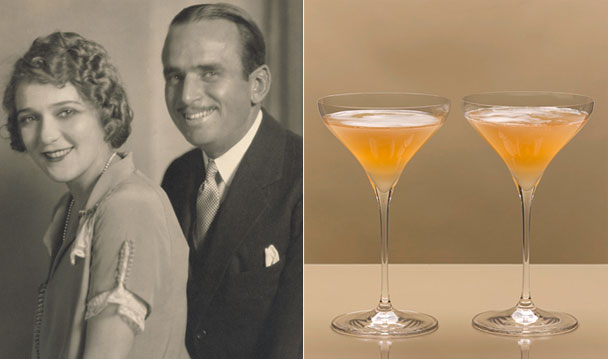If, last summer, you had slipped into many a Hollywood watering hole, chances are you’d have been able to order a cocktail named the Charlie Sheen. There was no general agreement about what this drink should contain. There was often some ironic version of “tiger blood” (be it tomato juice or Campari), but each bar had its own recipe. Rivalries between mixologists were intense but short-lived. By autumn no bar was featuring, and certainly no patrons were demanding, a Charlie Sheen. The actor had (mercifully perhaps) slipped out of the media klieg light, and the cocktail seemed no more current or fashionable than a Pet Rock.
Well, you might say, that’s the way things go in showbiz. It’s also the way things go with celebrity-name-checking food and drinks. In the afterglow of Charlie Sheen’s flameout, I turned to my copy of the Savoy Cocktail Book (there are multiple editions; mine’s from the 1970s). In its pages were drinks named after the likes of Harry Lauder, Will Rogers, and Johnny Mack, entertainers who were popular in their day but who no longer rank high on anybody’s Netflix list. At least there was Mary Pickford, an actress whose name still resonates as Hollywood royalty, and I think quite a few people still drink a version of her cocktail, which contains rum, pineapple juice, grenadine, and Maraschino, though the last time I had anything like that it was called a Zombie.
Perhaps the most enduring of all cocktails named after celebrities is the Shirley Temple, a nonalcoholic drink inspired by the child star, and according to some accounts invented by a barman at Chasen’s in Beverly Hills. It doesn’t appear in the Savoy book, perhaps on the grounds that it isn’t a “real” cocktail, but you will find in there the Melba cocktail named for Dame Nellie Melba: the drink combines rum, Swedish punch, grenadine, lemon, lime, and absinthe; I kid you not.
Dame Nellie never made it to Hollywood, since her heyday came before films with sound, though she has been depicted in movies. However when it comes to A-list cuisine few can compare to her: Napoleon is the only one who springs to mind. We’re all familiar with melba toast and Peach Melba, but she also gave her name to Melba sauce (puréed raspberries and red currants), and Melba Garniture (chicken, mushrooms, and truffles, inside a tomato, served with velouté sauce), though I can’t say I’ve ever seen that last one on a menu.
All these dishes were devised by Auguste Escoffier, though, in the case of melba toast this wasn’t so much an invention as a name change. Originally melba toast was Toast Marie, named after Madame Marie Ritz, and I imagine she must have been furious at having it taken away from her. Maybe she could console herself with Ritz Crackers, though I doubt it.
History suggests that Dame Nellie was happy to give her name to these dishes, but you can see there are certain foods you wouldn’t want your name attached to. There’s the famous episode of Curb Your Enthusiasm in which Larry David is initially delighted that his local deli has named a sandwich in his honor, then is bitterly disappointed to discover it contains whitefish, sable, cream cheese, capers, and onion. Personally I can think of far worse sandwiches, but I realize that would have left the episode without a plotline.
Sandwiches have always tended to have people’s names attached to them (not least that of John Montagu, the eponymous fourth earl). In many cases the origins are contested—we’re not quite sure which particular Reuben or sloppy Joe is being referred to. Here in L.A., for example, we’re pretty confident that the French dip was a local invention, but fights have broken out about whether it originated at Philippe’s or at Cole’s Pacific Electric Buffet. Some sources say it’s named after Philippe “Frenchy” Mathieu, who—one story holds—accidentally dropped a sandwich into the meat juices; others cite a cop named French who had bad teeth and needed the bread softened.
The Monte Cristo also (probably) originated in L.A., at the Brown Derby, gaining wider popularity in the 1960s when the Blue Bayou restaurant in Disneyland started serving it. The Monte Cristo in question is almost certainly the Count thereof, from the Dumas novel. That’s a literary source to some extent, but you just know that the guy who came up with name had seen the movie rather than read the book.
Junior’s, a landmark deli in L.A.’s Westwood neighborhood, serves up sandwiches named after showbiz awards: the Grammy, the Emmy, the Golden Globe and, first on the list, the Oscar, which is actually a not especially exciting beef-and-cheese combo. Naturally, the origins of the name “Oscar” for the statuette itself are fiercely debated. One story has Bette Davis naming it after her first husband, another has a secretary in the Academy Awards office saying the statuette reminded her of her Uncle Oscar. Either way, award and sandwich remain linked.
Of course, all this gives a man an urge to become eponymous himself, and I’ve been wondering what food I might put my name to. I may not be a star but I do live in Hollywood. I have been known to make a sandwich involving whole-grain bread smeared with Marmite, then filled with curried cottage cheese. My wife tells me that’s a dish that should not dare to speak its name, but I’d be happy to call it the Nicholson. However knowing how these things work, if it catches on at all, people will probably think it’s named after Jack Nicholson. Worse still, it might get reduced to the (infinitely undignified) sloppy Geoff. “Geoff who?” people will ask. Well, now you’ll be able to tell them.
Geoff Nicholson is a writer in Los Angeles. His books include the novel The Food Chain and the nonfiction Lost Art of Walking. His previous articles for Gourmet Live include “Recipes for Disaster,” and “Funny Food.”

